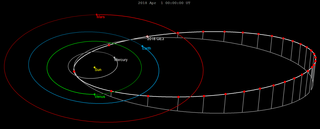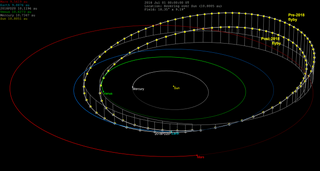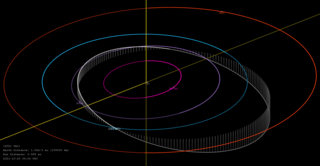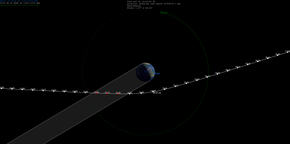2002 MN is the provisional designation given to a 73-meter Apollo near-Earth asteroid that on 14 June 2002 passed Earth at a distance of 0.0008 AU, about one third the distance to the Moon (0.3 LD). The close approach was second only to the Earth approach by the 10-meter asteroid 1994 XM1. 2002 MN was discovered on 17 June 2002, three days after closest approach. Its mass and relative velocity were in the same general range as the object ascribed to the Tunguska event of 1908, which leveled over 2,100 km2 (800 sq mi) of trees in Siberia. 2002 MN has an observation arc of 53 days with an uncertainty parameter of 6. There is a cumulative 1 in 360,000 chance that the asteroid could impact Earth sometime after 2070.

2009 VA is an asteroid that came within 14,000 kilometres (8,700 mi) of Earth on 6 November 2009 making it the third closest non-impacting approach of a cataloged asteroid.

2012 BX34 is a small Aten asteroid that made one of the closest recorded asteroid close approaches of Earth on 27 January 2012. It passed within 0.0004371 AU (65,390 km; 40,630 mi) of Earth during its closest approach at 15:25 GMT. 2012 BX34 measures around 8 meters (26 ft) across; if it had impacted in 2012, it would have been too small to pass through Earth's atmosphere intact.
2012 TV is a near-Earth Apollo asteroid with an estimated diameter of 30 metres (98 ft). Its closest approach to the Earth was on October 7, 2012 with a distance of 0.0017 astronomical units. It also approached the Moon an hour earlier with a distance of 0.0028 astronomical units. With a short observation arc of 1.8 days, the asteroid is listed on the Sentry Risk Table and has a 1:500,000 chance of impacting Earth on April 2, 2081.
2013 TX68 is an Apollo asteroid and near-Earth object discovered on 6 October 2013 by the Catalina Sky Survey, during which it was near a close approach of 5.4 Lunar distances (LD) from the Earth. The asteroid only has a 10-day observation arc which makes long-term predictions of its position less certain. It was observed for three days as it approached Earth in the night sky starting with the sixth of October, 2013. Then it became unobservable by being between the Earth and the Sun, then not recovered due to its small size and dimness. Precovery images by Pan-STARRS from 29 September 2013 were announced on 11 February 2016 that extended the observation arc to 10 days. It was removed from the Sentry Risk Table on 11 February 2016, so there is no risk of impact from this object for the next hundred years or more. The asteroid was last observed on 9 October 2013.
2017 AG13 is a small Aten asteroid that made a close approach of 0.54 lunar distances from Earth on January 9, 2017. It was the largest asteroid to pass less than 1 lunar distance from Earth since 2016 QA2 on August 28, 2016. The Catalina Sky Survey observed it first on January 7, 2017, only two days before its closest approach. At its brightest, 2017 AG13 reached apparent magnitude 12.2. Shortly after, it moved too close to the Sun to be seen by telescopes.

2018 CN2 is a very small asteroid, classified as a near-Earth object of the Apollo group, approximately 5 to 16 meters in diameter. It was first observed by astronomers of the Mount Lemmon Survey at Mount Lemmon Observatory, Arizona, on 8 February 2018, one day prior its close encounter with Earth at 0.18 lunar distances.

2018 BF3 is a micro-asteroid, classified as a near-Earth object of the Apollo group, approximately 20 meters (70 ft) in diameter. It was first observed on 20 January 2018, by astronomers of the Catalina Sky Survey at Mount Lemmon Observatory in Arizona, United States, the day after the closest flyby, due to its approach from the direction of the Sun.

2018 DV1 is a micro-asteroid, classified as a near-Earth object of the Aten group, approximately 6–12 meters (20–40 feet) in diameter. It was first observed on 26 February 2018, by astronomers of the Mount Lemmon Survey at Mount Lemmon Observatory, Arizona, five days prior to its sub-lunar close encounter with Earth at less than 0.3 lunar distance.

2018 GE3 is a sub-kilometer asteroid on a highly eccentric orbit, classified as a near-Earth object of the Apollo group, approximately 48–110 meters (160–360 feet) in diameter. It was first observed on 14 April 2018, by astronomers with the Catalina Sky Survey one day prior to its sub-lunar close encounter with Earth at 0.5 lunar distance. It is one of the largest known asteroids (possibly the largest) in observational history to ever pass that close to Earth (also see list).

2010 WC9, unofficially designated ZJ99C60, is a sub-kilometer near-Earth asteroid of the Apollo group, approximately 100 meters (330 feet) in diameter. First observed for eleven days by the Catalina Sky Survey in 2010, the asteroid was recovered in May 2018 during its sub-lunar close encounter with Earth.

2018 PD20 is a small asteroid, classified as a near-Earth object of the Apollo group, approximately 9–20 meters (30–66 feet) in diameter. On 11 August 2018, it was first observed by ATLAS at the Mauna Loa Observatory on Hawaii (T08), when it passed 33,500 kilometers (20,800 miles) from the Earth. This is notable because it came within a tenth of the lunar distance, or 0.10 LD which is closer to Earth than satellites in a geostationary orbit. These have an altitude of 0.11 LD, about 36,000 km (22,000 mi), approximately 3 times the width of the Earth.

2019 AS5 is a near-Earth asteroid that passed close by the Earth on 8 January 2019. It passed within 0.04 lunar distances or 15,000 kilometers of the center of the Earth, 8600 km from the surface. It was discovered by the Mt. Lemmon Survey 9 hours after closest approach. It is estimated to be about 1–2 metres (3–7 feet) in diameter.

2018 XB4 (also written 2018 XB4) is an Apollo near-Earth asteroid roughly 53 meters (170 feet) in diameter. It was discovered on 13 December 2018 when the asteroid was about 0.125 AU (18,700,000 km; 11,600,000 mi) from Earth and had a solar elongation of 146°. It passed closest approach to Earth on 1 January 2019. Of the asteroids discovered in 2018, it had the highest Palermo scale rating at –3.6. In mid-2019 it was recovered which extended the observation arc to 177 days and was removed from the Sentry Risk Table on 12 June 2019. It is now known that on 22 June 2092 the asteroid will pass about 0.033±0.015 AU from Earth.
2019 TA7 is an Aten (NEO) asteroid, estimated to be about 34 meters (111 feet) in diameter, that was first observed on 9 October 2019, and flew pass the Earth at 38,100 km/h (23,700 mph), about 0.01 AU (1,500,000 km; 930,000 mi) away, its closest encounter in 115 years, on 14 October 2019 at 6:53 pm ET.
2019 UN13 is a small near-Earth asteroid roughly 1–2 meters in diameter. Even though the asteroid was in the night sky for months, it was fainter than the sky survey limit of apparent magnitude 24 until 29 October 2019 when the asteroid was two million km from Earth. It was discovered on October 31, 2019, passing 6,200 km above Earth's surface.

(501647) 2014 SD224 is an Aten near-Earth asteroid around 150 meters (490 feet) in diameter. It was discovered on 22 September 2014 when the asteroid was 0.29 AU (43 million km; 110 LD) from Earth and had a solar elongation of 123 degrees. The glare of the Sun had masked the approach of the asteroid as it passed closest approach to Earth on 11 August 2014. The asteroid now has a 6-year observation arc and a well-determined orbit. It also makes close approaches to Venus.
2020 CW is a tiny near-Earth asteroid of the Apollo group, approximately 1 meter (3 ft) in diameter. It was first observed by the Mount Lemmon Survey on 1 February 2020, when it passed Earth very closely at a nominal distance of only 0.041 lunar distances. The object's orbital elements remain highly uncertain.
2020 UA is a tiny near-Earth asteroid around 5–12 metres (16–39 ft) across that passed within 46,100 km (28,600 mi) of Earth on 21 October 2020 at 02:00 UT.

2021 UA1 is a small (~2 meter) near-Earth object that passed about 3047 km from the surface of Earth while passing over Antarctica on 25 October 2021 around 03:07 UT. Given the small size of the asteroid it only reached the brightness of Pluto at around apparent magnitude 14. Since it approached from the direction of the Sun, it was not discovered until 4 hours after closest approach.












